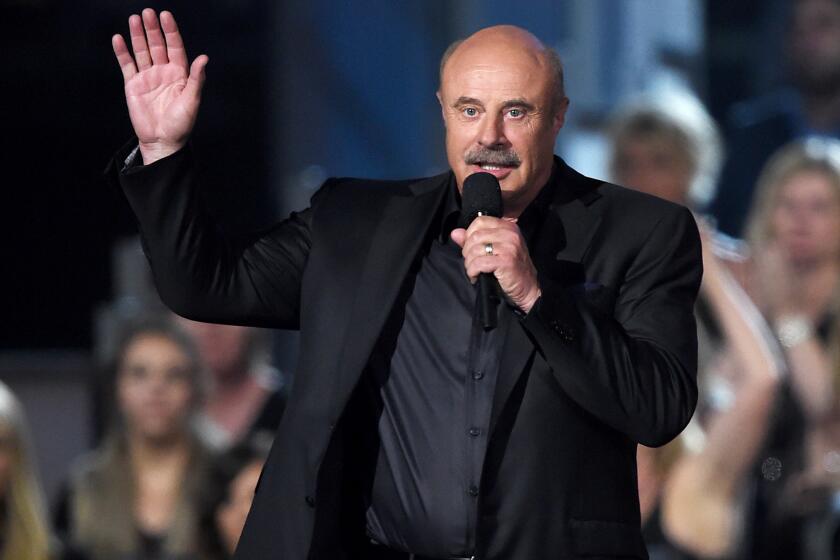Benjamin Britten triumphs in San Francisco
- Share via
Reporting from SAN FRANCISCO — When Peter Grimes “is at his exercise,” boys die.
The title character of Benjamin Britten’s first and best-known opera is a social outcast in a claustrophobic fishing village on the raw British coast. A violent visionary, Grimes is abusive toward his young assistants, his actions tell us. He is not a bad man, Britten’s remarkable music tells us.
The questions “Peter Grimes” poses are sizable. At what point does society turn an individual into a psychopath? At what point does empathy become iniquitous? Operatic calculus cannot, perhaps, solve these most complex of moral equations, but it can help.
Over the weekend, the San Francisco Symphony ended a three-week Britten Centennial Celebration with a magnificently mortifying semi-staged “Grimes,” conducted by Michael Tilson Thomas, alongside a bewitching suite from Britten’s Balinese ballet, “Prince of the Pagodas.” The conditions inside and out of Davies Symphony Hall, as well as the performances, were extraordinary.
“Grimes” had its origins in Southern California when the British composer and tenor Peter Pears were waiting out World War II in Escondido. Britten’s social alienation was at its peak. He was not yet a national figure in England. He was a pacifist who fled his homeland rather than fight or face arrest. He was gay during intolerant times.
He felt an outsider on all fronts. Yet with “Grimes,” which fostered a renaissance of British opera, Britten became the ultimate insider composer in Britain. Plus, the enormous success of the opera allowed him to further explore in his celebrated body of work essential social, sexual and controversially left wing themes that had not before been the purview of mainstream classical music.
For its semi-staging, the San Francisco Symphony created its own effectively claustrophobic space by surrounding the stage with two rough-edged cycloramas behind the orchestra. Misty images of the waves, the sky and the village were projected on them. The chorus sat in between them. Being in the audience felt like sitting inside a ship, looking out at the dreary coast. James Darrah, the director and costume designer, offered a sea of gloomy grays and rough-hewn villagers to complete the picture.
There was talk that the screens affected the acoustics, although that doesn’t seem physically very likely, since they weren’t exactly acoustical panels. The fact that the orchestra had an unusually thick, bass-rich, dark sound was, I suspect, mainly the work of Tilson Thomas. Psychoacoustics may have played a role.
But the immediacy of the orchestra added genuine profundity to Australian tenor Stuart Skelton’s already exceptional Grimes. He was Grimes as a seer, controlled by forces not easily understood. The set, the townsfolk and the chorus closed in on him. The orchestral sound was huge. Instrumental textures were convoluted, with the brass, in particular, demanding to be obeyed.
Rather than a sadist, Skelton’s compellingly demented Grimes, in this setting, was a victim of larger forces. Normally we empathize with Grimes, seeing him reflected through Ellen Orford. She is one villager on his side and was forcefully sung by Elza van den Heever.
But Britten’s is primarily an ecological opera. Inhospitable weather and terrain produce the need for social unity and thus conformity. An outsider cannot survive. The set, the excellent direction, a tight and theatrical cast and evocative projections all made that devastatingly visceral.
The context of the weekend added more. San Francisco happened to be in both celebration and commemoration mode. Another centenary was being acknowledged — the start of World War I. (Texts by World War I poet Wilfred Owen formed the basis for Britten’s pacifist masterpiece, “War Requiem.”) Plus it was gay pride weekend.
It was as if Britten’s battles had been won. Peace and tolerance were in vivid evidence at Civic Center, across the street from Davies Hall. Street-partying throngs wore colorful thongs. Peace symbols were everywhere. Even the sun was shining (not a predictable San Francisco treat).
If “Grimes” was a somber reminder of less hospitable times and climes, “Prince of the Pagodas,” the inexplicably neglected ballet with its Tchaikovskian instrumental sugar plums and its wondrous Balinese gamelan imitations, was the perfect Britten romp for the weekend. The program book reproduced a photo of Britten and Pears in wonderfully camp native dress on a trip to Indonesia.
But a 44-minute suite removes far too much of this marvelous score. Every instant of the two-hour ballet has something of delight in it. “Pagodas” was not for Britten superficial escapism but rather a farsighted experiment in musical equanimity by finding an arresting common ground between East and West, between Modernism and Romanticism.
It was not, however, an altogether innocent soundtrack for a modern San Francisco where celebrants and Silicon Valley denizens step over the homeless, where social equality has yet to restore economic inequality. Britten insisted on all of it.
That insistence also made a special performance of the “Four Sea Interludes” from “Grimes” that preceded the “Pagodas” suite Saturday regrettable. The interludes were accompanied by a video commissioned from Tal Rosner by four orchestras, including the Los Angeles Philharmonic. Rosner synchronized antiseptic shots of bridges and rivers, along with the abstract designs, to Britten’s score. Nothing was accomplished in the process.
But much was accomplished by the vehement magical realism of Tilson Thomas’ conducting. It turns out that he will bring the “Four Sea Interludes” to Walt Disney Concert Hall next season with the touring London Symphony Orchestra. Not to worry, the L.A. Phil has yet to program the video.
More to Read
The biggest entertainment stories
Get our big stories about Hollywood, film, television, music, arts, culture and more right in your inbox as soon as they publish.
You may occasionally receive promotional content from the Los Angeles Times.











